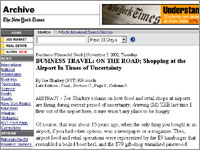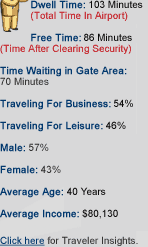


 The New York TimesNovember 5, 2002, Tuesday BUSINESS TRAVEL: ON THE ROAD; Shopping at the Airport In Times of UncertaintyBy Joe Sharkey (NYT) PITTSBURGH -- THE last time I flew out of the airport here, it sure wasn't any place to be hungry.
Regular users of the Pittsburgh airport, where US Airways accounts for about 90 percent of the flights, might well scoff at this revelation. In 1992, Pittsburgh was the first major domestic airport to thoroughly redesign its terminal and concourses to accommodate a shopping mall-like retail and food center called Airmall. The mall was developed and is still managed under long-term contract by BAA, the company that runs Heathrow and six other airports in Britain. Airmall led the way in prompting American airports to spend many billions of dollars remaking drab, military-style terminals into bustling, well-designed places for passengers to shop and eat reasonably well while waiting for a plane. So it would seem to be a logical place to stop, look around and ask how airport retail is faring these days, as business travel begins a slow resumption toward levels of previous years. Here at midday yesterday, restaurants and snack bars seemed to be doing a brisk business, as many passengers relaxed over lunch or bought take-out food to carry aboard flights where food service is now defined as a half-ounce bag of pretzels. Newsstands, book stores and drug stores also had a lot of customers. Clothing shops and jewelry stores appeared to be empty, with bored clerks listlessly polishing glass display cases. Some shops have been smart enough to anticipate shifts in buying behavior caused by the peculiar hurry-up-and-wait environment at the airports. An example: a luggage and handbag store called Wilsons the Leather Experts, where the sales clerk, Velia Mastramico, was busy showing off a line of carry-on bags in various styles. Often, passengers who have just struggled through security checkpoints with several bags will spot the store's displays, come in, and immediately buy a new bag. ''I just had a gentleman come in with an older bag that he suddenly decided he had to replace,'' Ms. Mastramico said, holding up the worn but very serviceable leather valise that the customer left behind after buying a new roll-aboard to consolidate carry-on possessions as he bounded for his plane. Innovation and smarter customer service like that may well be the key for survival for airport retail operators nationally. Many have been trying to negotiate breaks on their leases with airports, citing the decline in passenger traffic. Ira Weinstein, president of Airport Interviewing and Research, a firm in White Plains, that does focus group and other surveys for airport clients, said that airports needed to think smarter about passenger behavior in the new environment. On the one hand, people are still arriving at airports far earlier than they did before the Sept. 11 terrorist catastrophe. But the time spent at airports has started to fall off slightly, based on interviews Mr. Weinstein's firm did in September and October with 4,000 travelers at major hub airports, he said. According to that survey, the average amount of time spent at an airport is 104 minutes. After ticketing and security processing, the average amount of free time a passenger has before a flight is 85 minutes, which theoretically should suggest lots of time for leisurely shopping or dining. But there is a behavioral hitch. Right now, most passengers still feel more comfortable heading quickly to departure gates, which are typically away from the main retail areas. The average time spent at departure gates exceeds one hour, said Mr. Weinstein, who believes airports need to think more about providing a greater number of small but convenient food, retail and newsstand outlets closer to gates. After the terrorist attacks, the percentage of passengers who make any purchase ''spiked up to around 60 percent, from the low 50's,'' as people lingered longer in airports, Mr. Weinstein said. Now about 68 percent of passengers spend money shopping or eating in airports, Mr. Weinstein said. More than half buy only food and drinks. This category is experiencing sharp growth, while retail is not. ''Average spending on food and beverage has gone up $2 to $3 since before 9/11 to about $8.50 now,'' Mr. Weinstein said. ''People know that airplanes often aren't serving food.'' In Pittsburgh, the pioneer retailer Airmall is holding its own so far, with $80.7 million in gross sales last year, slightly higher than 2000, according to Airport Revenue News, a trade magazine. But Pittsburgh, where Airmall recently marked its 10th anniversary,
has a very big challenge to overcome. Slashing costs and operations
as it struggles to come out of bankruptcy, US Airways has cut about
one in five flights to and from Pittsburgh. More cuts may be coming
to an airport with only one major player. Copyright 2002 The New York Times Company
|
|
|||||||||
| home | about us | services | methodologies | clients | press | contact us |
 Of course, that was about 15 years ago, when the only thing you
bought in an airport, if you had other options, was a newspaper
or a magazine. Then, airport food and retail operations were represented
by the $9 hamburger that resembled a boiled boot heel, and the $79
gift-shop varnished pinewood music box that played ''Laura's Theme''
from ''Dr. Zhivago'' and had the words ''Greetings from Pittsburgh,
Pa.'' stenciled on the lid.
Yesterday at lunchtime, though, while waiting for a midafternoon
flight home, I wandered Pittsburgh International Airport blinking
at the bewildering choices on display: 27 restaurants and snack
bars, 43 retail stores ranging from Eckerd Drugs to Victoria's Secret,
more than a half-dozen newsstands, a post office, a video arcade,
a bank, two massage parlors and a chapel.
Of course, that was about 15 years ago, when the only thing you
bought in an airport, if you had other options, was a newspaper
or a magazine. Then, airport food and retail operations were represented
by the $9 hamburger that resembled a boiled boot heel, and the $79
gift-shop varnished pinewood music box that played ''Laura's Theme''
from ''Dr. Zhivago'' and had the words ''Greetings from Pittsburgh,
Pa.'' stenciled on the lid.
Yesterday at lunchtime, though, while waiting for a midafternoon
flight home, I wandered Pittsburgh International Airport blinking
at the bewildering choices on display: 27 restaurants and snack
bars, 43 retail stores ranging from Eckerd Drugs to Victoria's Secret,
more than a half-dozen newsstands, a post office, a video arcade,
a bank, two massage parlors and a chapel. 
